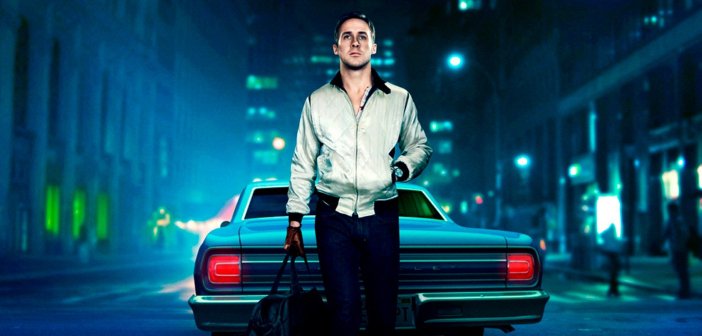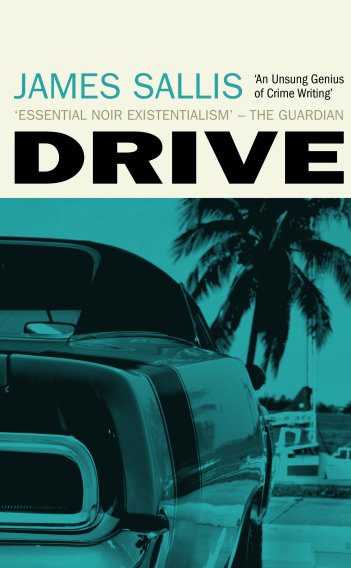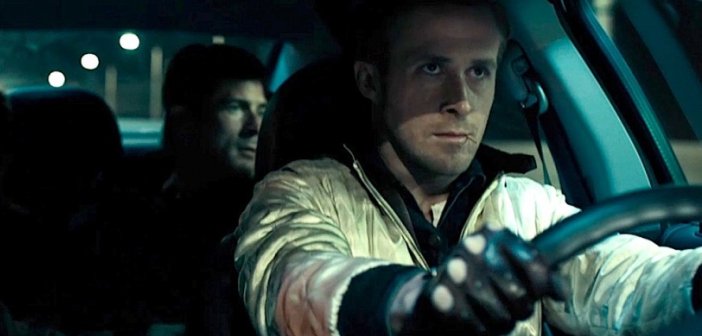Literature on Film |18| In both Book and Film the Heart of Drive is not Style, but Substance of Character
All love stories have a natural darkness to them; a crazy ex, a fear of being alone or perhaps even a terminal illness. James Sallis’ 2005 novel Drive and Nicolas Winding Refn’s adaptation of the same name bring that darkness into the light. Both depict a man known to the audience only as Driver and both seek to reconnect him with emotions he lost long ago. Driver is adrift in a neon-soaked hell full of fast cars, headstrong criminals and his own emotional emptiness. While Sallis’ novel focuses on the story of a man learning that his emotions can save rather than destroy him, Refn instead focuses on the love story that gives the film its beating heart.
The love story of Drive is one so intentionally implicit it may as well be explicit. Driver (Ryan Gosling) meets his new neighbor Irene (Carey Mulligan) and all of a sudden both their lives change. Driver finds himself able to connect with someone while Irene finds someone she can look to for support while her husband, Standard Gabriel (Oscar Isaac), is in jail. This romance is told through few words and even fewer actions. It is communicated through long looks and stolen glances all scored by Cliff Martinez’s haunting synth-pop soundtrack and shot through Newton Thomas Sigel’s fairy-tale cinematography. This is something both the novel and film have in common: atmosphere.

Driver has few friends in both versions. He spends much of his time tinkering in his mentor Shannon’s (Bryan Cranston) shop, performing movie stunts and moonlighting as a getaway driver for thieves. The audience is often incapable of reading his thoughts and view him like an emotional enigma waiting to be solved. Driver looks at other characters in the same way. His isolation is so complete that the viewer and reader both cannot help but feel sympathetic for such a lonely individual. Anchored by Gosling’s performance, the character practically bleeds pathos. Every look, quirk of the mouth or twitch of the brow is so full of longing and hope that the viewer can soak in this powerful piece of character acting without worrying as to why Driver only ever responds to one in five questions he’s asked. Anonymity is a tool Refn relies on to tell the character’s story. He allows the audience to put their own projections onto these characters much like his other films Bronson, Valhalla Rising and Only God Forgives. Sallis however leads his readers along with a trail of breadcrumbs. The reader is fed tidbits of information about Driver and the supporting cast.

Sallis describes the physically lanky Driver as “something of a stranger to and in his body”. He amends this rather lame and dorky description a few lines later with the statement “One thing he could do, though, was drive. And he drove like a son of a bitch”. The former description is rather at odds with the living sculpture that is Ryan Gosling in Refn’s film. Sallis’ character arguably has more depth than Gosling’s own interpretation. His childhood with his apathetic father, mentally ill mother, kindly foster parents and a large surrogate family of Mexican immigrants is described in detail. No other character gets as much exposition as Driver other than perhaps Bernie Rose (played in the film version by Albert Brooks).
Bernie is the villain of the film alongside Ron Perlman’s Nino. Bernie and Nino are Jewish mobsters who have bitten off more than they can chew in L.A leading to the former best friends becoming more and more distant from one another. Bernie just wants to survive whereas Nino wants to thrive. In both the book and the film Nino is indirectly responsible for Standard Gabriel’s death. Driver sets out on a winding course of revenge, killing everyone that even knew something about the robbery Standard was killed in. Bernie sets out to save his old friend Nino. As the film and book progress they converge at the point where Driver and Bernie begin to seem similar. Bernie is not evil he is just making the most out of the opportunities he was given. Much the same as Driver is. Both are men who only use violence in the most extreme circumstances. Ultimately both men are adrift in a world neither understand.
Violence is one thing both Sallis’ novel and Refn’s film have in common. Actions in Drive speak far louder than any of the hushed, minimal dialogue. Drive’s neo-noir aesthetic separates it from the grimy gore fest that was Refn’s follow up film, Only God Forgives. Drive’s violence takes place in bursts. There are no drawn out punch-ups, gun fights or torture sequences. On the streets of downtown L.A it’s kill or be killed and Driver takes no prisoners. Whether it’s Christina Hendricks as Blanche, the red herring femme fatale, having her head blown to pieces, Driver crushing a man’s head or Bernie Rose slowly slicing open Shannon’s lower arm with a straight razor it’s true that Drive is not for the faint of heart even if it is a romance at its core. Sallis’ use of violence also borders on gratuity. “Blanche’s shoulders lay across the bathroom door’s threshold. Not much of her head left in there: he knew that”. Both director and author use violence like Bernie uses his razor. It upsets the romanticism of both stories. Violence casts an ugly, bloody pall over both stories just as it does in real life. Violence grounds Drive like it grounds any good fairy-tale. Whether it’s the Big Bad Wolf’s teeth or Prince Charming’s sword, violence can either save or destroy depending upon one’s perspective.

Drive is a fairy-tale. Especially in the film’s case. It demands the viewer’s suspension of disbelief more than most films do. No romance that clear cut can exist. Romance is complicated but the silently simple way Refn presents it in not only convinces but forces belief upon the viewer. In an interview Refn was asked about his first meeting with Gosling. In short Refn, while high off anti-fever medication and after an awkward first meeting with Gosling, began to cry in front of the actor over the song I Can’t Fight This Feeling Anymore. He then said: “I know what Drive is. It’s about a man who drives around at night listening to pop music, and that’s his emotional relief.” To which Gosling responded: “We’re doing it.” It is this emotional and romantic resonance that elevates Drive beyond the stylish indie thriller many first thought it to be.
The final and lasting difference between the novel and the film is what their focus is. Sallis’ novel is about a city’s dark underbelly and the forgotten sinners forced to eke out an existence in it. Refn narrows down this cast of sinners to focus on Driver, much like he did in his films Bronson and Valhalla Rising before and in Only God Forgives after. All four films focus on a man trapped in some hell of his own making and end in an often spiritual or emotional escape. Sallis seeks to understand a city where poverty is the gnarled, blackened tree from which every other societal evil grows from. Refn seeks to understand human emotion and romance from the point of view of a man who has remained at a distance from these two interconnected things. Together both novel and film tell a complete story of an individual and communal struggle not just to survive, but to live.

